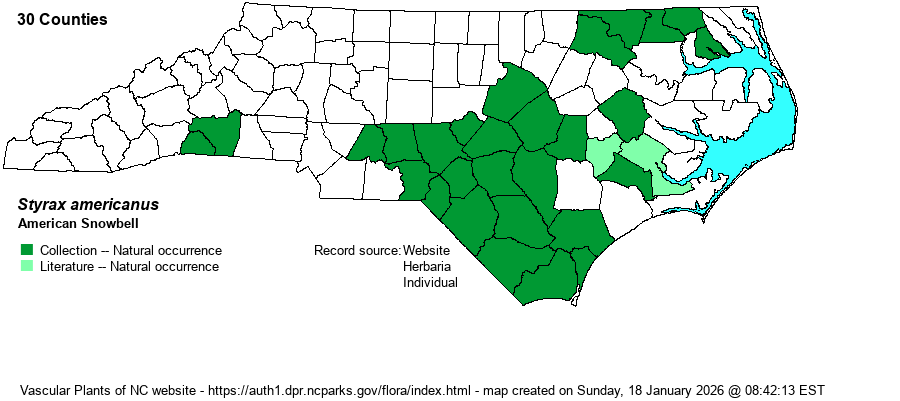| Author | Lamarck | |
| Distribution | Essentially throughout the southwestern half of the Coastal Plain, but of spotty distribution north and east of Johnston and Wayne counties. Undoubtedly absent from many far eastern counties (east of Perquimans, Pitt, and Craven counties). Ranges west to the eastern edge of the Piedmont, sparingly, and seemingly disjunct to the extreme southwestern counties there. Certainly absent from nearly all the northwestern 50% of the state.
This is primarily a Coastal Plain species, ranging north to eastern VA and (in the Mississippi drainage) southern IL and southeastern MO. It occurs south to southern FL and eastern TX. It is essentially absent from montane areas.
| |
| Abundance | Uncommon to locally fairly common in the Sandhills and to the east in the southern Coastal Plain. Generally rare farther northward and northeastward. Very rare to rare in the narrow Piedmont range. Not really common anywhere in the state, though found in all counties from Wake and Johnston south to the SC line (Richmond to Brunswick counties). | |
| Habitat | This species occurs mainly along the margins of wet or damp forested habitats, in generally blackwater conditions. It is often found along a swamp margin, or edge of a pocosin, or along a small blackwater stream, though it is not typically considered as a true “pocosin” shrub. It can occur in wetland pools and along Piedmont streams, again mostly where partly exposed to sunlight. |
| Phenology | Flowers from April to June, and fruits from July to September. | |
| Identification | This species, despite a wide range in the state, is unfamiliar to most biologists, as it is seldom really numerous. It is a fairly tall deciduous shrub, averaging about 8-10 feet tall, and is essentially never a small tree. The alternate leaves, though widely elliptical and essentially entire, tend to have irregular margins (and an occasional small tooth), so the effect is that the margins are not usually smoothly rounded. They are rather small, averaging only about 2 inches long. If visible, the flowers should clinch identification, as they are dangling, white, numerous along the branches, and with mostly five strongly recurved petals. Both species of Styrax in NC have these flowers, and both have distinct naked end buds that are visible in early spring. However, S. grandifolius is mostly an upland species, grows to a large shrub or small tree, and has much larger leaves. Most people would simply overlook a non-flowering S. americanus as a highbush blueberry (Vaccinium) or some other wetland ericad like Maleberry (Lyonia ligustrina); however, the end buds and leaves are distinctive once learned. | |
| Taxonomic Comments | Weakley (2018) and some other references split the species into varieties; the one in NC is the nominate form – S. americanus var. americanus. Into much of the last century, the species was named as Styrax americana.
| |
| Other Common Name(s) | American Storax | |
| State Rank | S3 [S3S4] | |
| Global Rank | G5 | |
| State Status | | |
| US Status | | |
| USACE-agcp | FACW link |
| USACE-emp | OBL link |

